30 Dec 2013 – 23 Jan 2014. Cusco and Ollantaytambo, Peru
From Don: 30 December 2013. The luxury train from Puno to Cusco exceeds my expectations: Pullman class coaches, comfortable armchair seating facing forward, and a table, with a smooth white cloth and a vase of flowers, just for the two of us: luxury. Even the bathrooms are luxurious. We order lunch from an elegant menu and watch the world go by. I can see the main road running more or less parallel with the train tracks: there’s no doubt in my mind where I’d rather be. Ali remarked that our attitude towards money has changed so much since we began our nomadic odyssey, and it’s absolutely true: there has been a tectonic shift in my attitude and in hers. I pay for hotels, planes and trains now without concern or worry about the future, even though I have no idea what the future may hold.
Ten hours on a bus can be an eternity. We’ll see what ten hours on a train feels like. Ali is writing her next blog post. I’ll continue with writing Morning Pages for a while, interspersed with staring out of the train windows. I keep thinking about going to the bar car to get a cup of tea, but then I can’t be bothered. The terrain so far has been quite flat, but I know that we’ll be climbing up to a high point in the Andes partway through the trip.
Finally we ordered cups of té negro con leche from one of the many staff patrolling the train. The car we’re in was still quite cool so we asked for and received blankets to keep our legs warm. Everything we could need or want for our journey is so easily to hand.
Passing through Juliaca there are market stalls jammed right up to the edge of the rail line: it reminded me of a market we saw in Southeast Asia where the stalls have to be removed every time a train comes through. Here though the stalls don’t have to be removed, and there are only six or seven trains a week passing through the market. Looking out from our privileged positions on the train to the hardscrabble lives of those living by the edge of the tracks made me realize why the peasants revolt from time to time. We have been given the lives we have by the Grace of God: not because we are better than, or smarter than, or more deserving than the folks living by the tracks in Juliaca. So I keep giving thanks for all that we are receiving.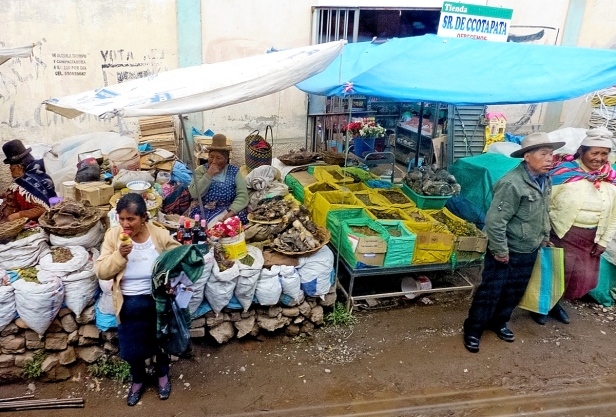
The train began climbing after we left Juliaca, and I could see ahead and to the left of us the foothills of the Andes. Eventually we arrived at the highest point on our journey at 4300 metres.
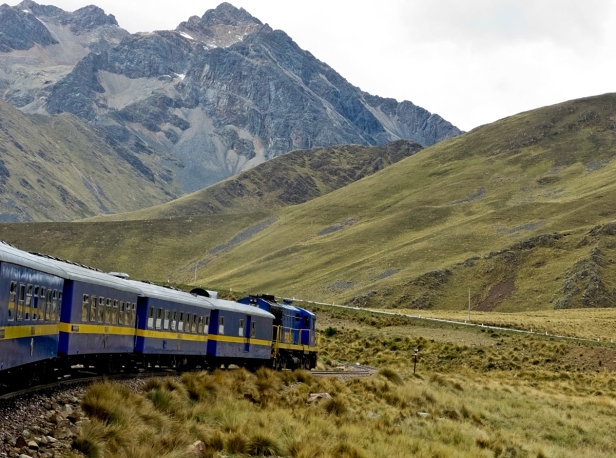
Lunch was served at around noon, and afternoon tea at 4:30. Fine-dining service and good food. Pisco sours were handed out in the morning and again in the afternoon, and a champagne and peach juice cocktail was served just before the afternoon tea. Some of our neighbours from Brazil also had a bottle of wine in the morning after their Pisco sours and wine with their lunch. I wouldn’t have been standing, but they seemed fine with it.
From Alison: Well ten hours on a train, on that train, turned out to be pretty sweet. The last carriage was a bar car and the back of it was open to give unobstructed views. There were also some performances of traditional music and dancing to keep us entertained.
Along the way we saw many sheep and llama farms with their mud brick buildings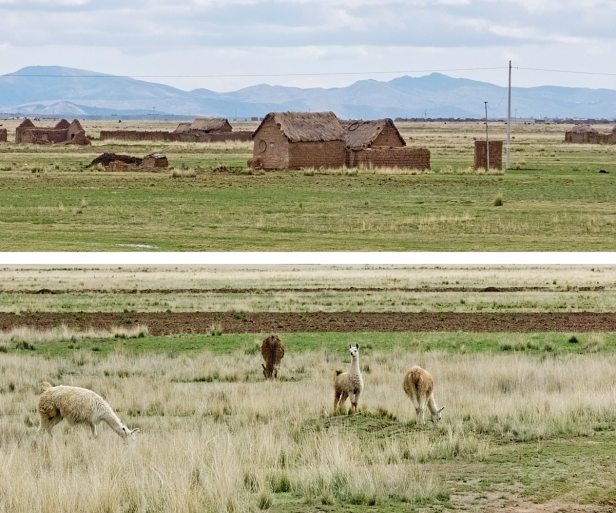
and further along lush crops covering the land.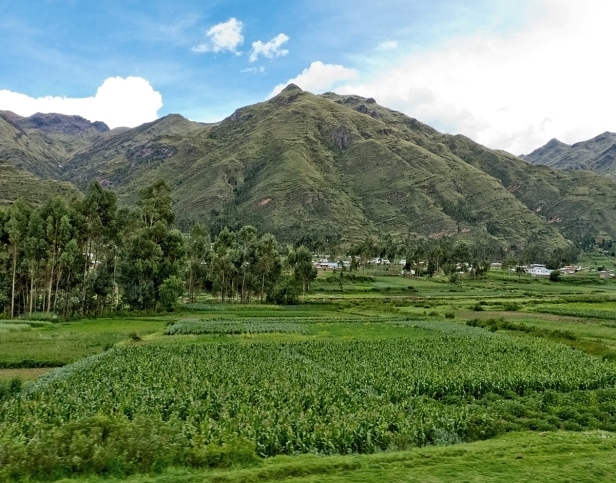
From the back of the train. I guess he saw me.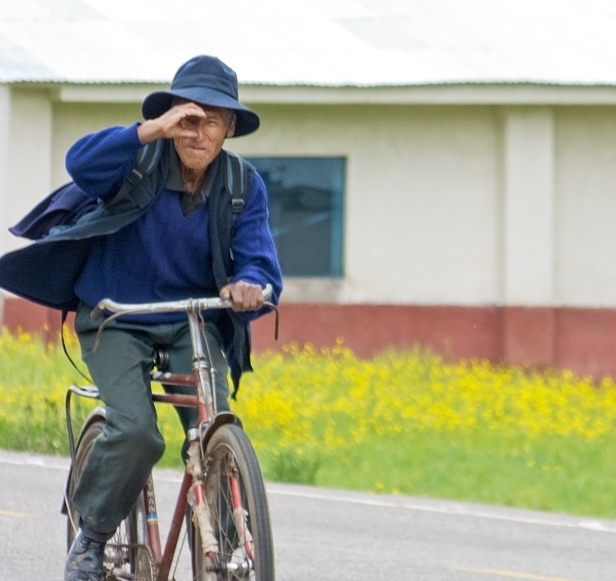
New Year’s Eve in Cusco was a complete bust. During the day, in a down home café, we met a couple of guys from Lima. They’d come to Cusco for NYE, saying it is the best place in Peru to celebrate, and that there would be a huge party in the main square. We each had a bowl of truly fabulous soup for lunch and they encouraged us to try the local drink – non-alcoholic fermented quinoa juice. Yeah. That was a big mistake. It actually tasted quite good if you don’t mind the fermented taste. It didn’t take long for me to start feeling sick. My entire body was rebelling. Still, we managed to see the main square, Plaza des Armas, and some of the ancient streets before heading urgently back to our hotel room.
Don’s photo of Plaza des Armas.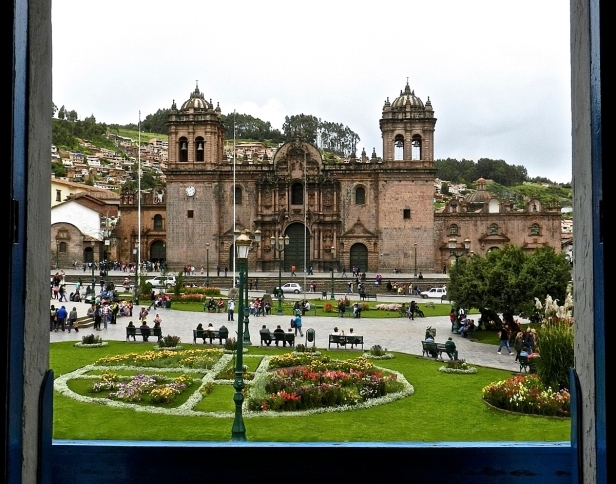
The ancient narrow streets of Cusco.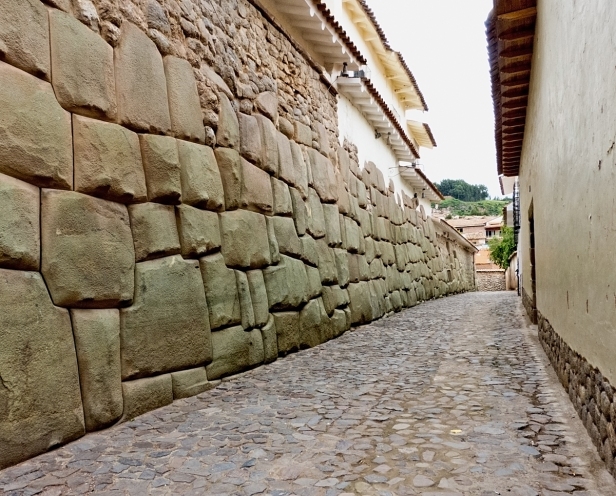

Everyone talks about Cusco being an Inca city but the area was inhabited by the Killke for several hundred years before the Incas arrived in about 1200. The Incas built on Killke structures, and the Spanish, in turn, from 1535, built on the massive stone walls constructed by the Incas. They destroyed the temples and palaces of the Incas but retained the indestructible stone foundations and built churches and mansions on them.
Inca stonework is extraordinary in that it was constructed in such a way that they neither used nor needed mortar, and yet the walls stand, even in the face of earthquakes (one in 1950 destroyed one third of the city’s buildings), and the stones are so tightly fitted together that it is impossible to get even a knife blade between them. No one knows how they did it, or where the stones came from.
Cusco was the capital, and heart of the Inca Empire, and in turn became the Spanish centre for colonization and the spread of Christianity in the Andes. Dig a little and you will find that Cusco goes back in time through layers and layers of civilization. It reminds me of the 12th century Basilica di San Clemente in Rome. Digging beneath it a 4th century basilica was discovered, and beneath that a 1st century home and Mithraic Temple. Cusco is like that. We felt a palpable sense of history as we walked the streets marvelling at the sophistication of the Inca foundations.
Twice we were lucky enough to be out and about when there was dancing in the streets. The first photo is similar to many parades we’ve seen in Andean South America that combine indigenous dancing with a solemn Catholic procession. Behind the dancers is a group of people in dark clothing carrying a religious effigy, in this case a deeply distressed Christ figure. Presumably they were headed to one of the town’s many cathedrals.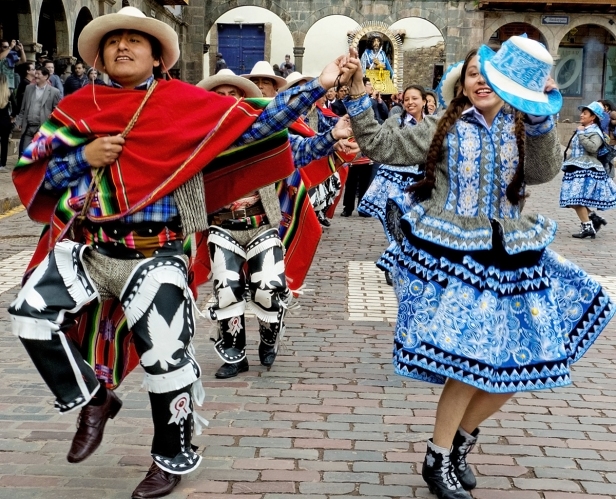
I know nothing about this dance group, or why they were dancing. They suddenly appeared in Plaza des Armas. There were about ten of them all dressed alike, and another man dressed as a woman with a very long nose. They danced for about half an hour. And then, after mingling with the crowd for a while, it was over and they were gone.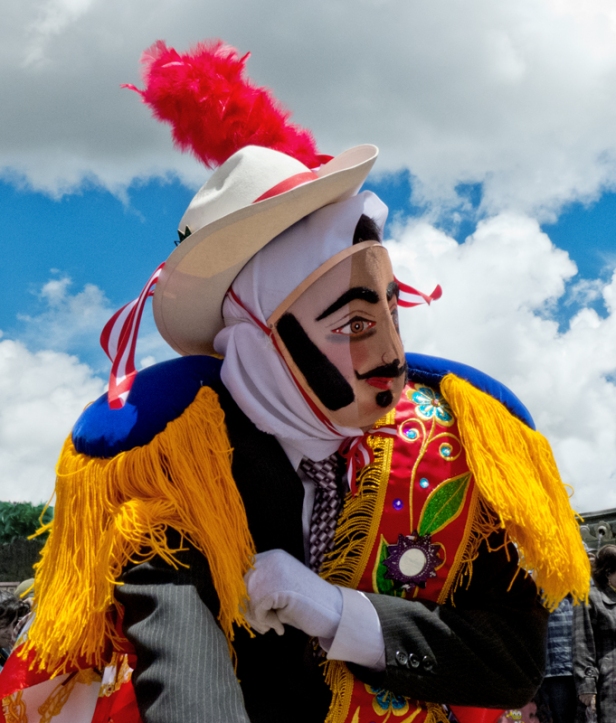
Exploring the local market,

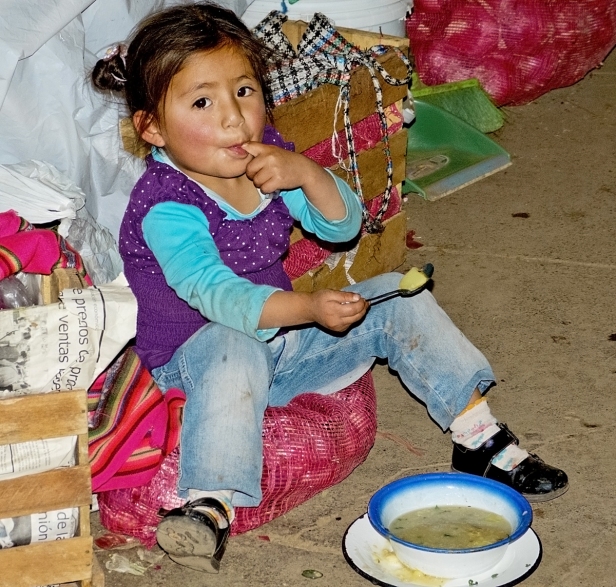
and wandering the streets.

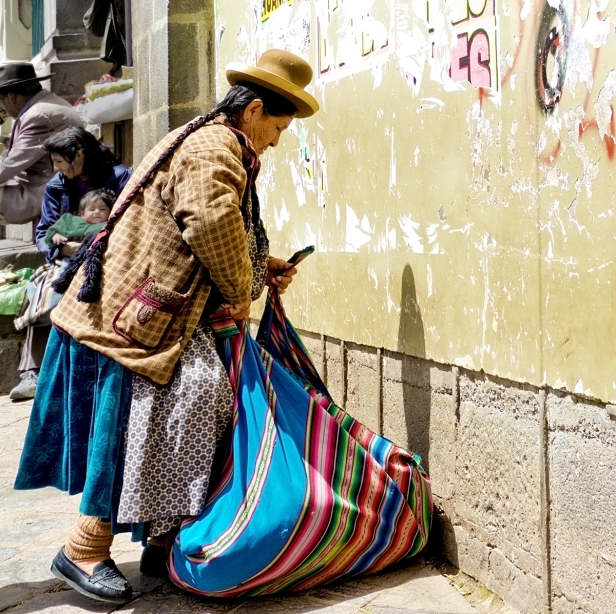
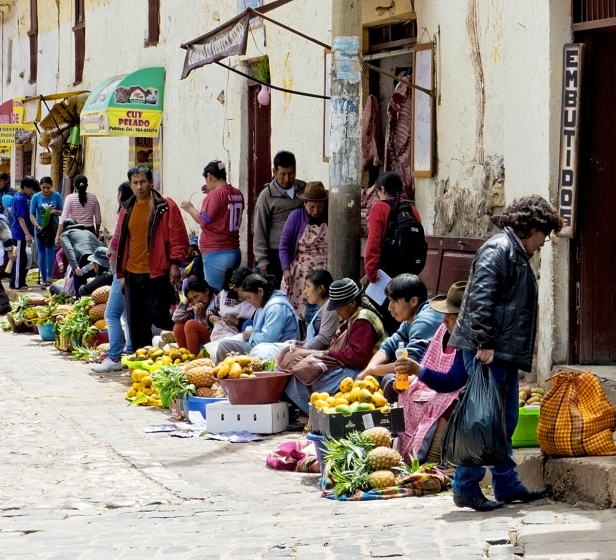

On one of the hills surrounding Cusco are the ruins of Sacsayhuaman (or sexy woman – an approximate pronunciation), an ancient fortress of the Killke people. The fortress also contained temples indicating it was used for religious as well as military purposes. It was later added to and used by the Inca.
So of course we hiked up the endless stairs to have a look at it, meeting various people and dogs along the way. There were many buenos dias’s said, and some brief Spanglish conversations. It was stairs all the way up. All the way up past the homes of the ordinary people of Cusco. No cars make it up here. Either walk up from the town below, or take a taxi to the main road at the top and walk down.
A view of Cusco from the top of the hill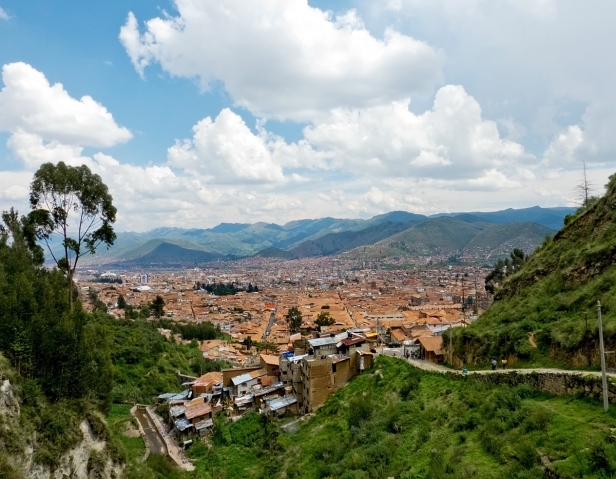
The Sacsayhuaman site is huge. We spent an hour or two wandering around, impressed by the enormous time, effort and dedication needed to create it. But frankly I was more interested in the llamas that were grazing there. Or are they alpacas? If I see the two side by side I can tell the difference. Alpacas have shorter legs, shorter snouts, and more wool around their faces. But this lot was all so wooly I couldn’t be sure. I think the first photo is probably an alpaca, the second probably llamas.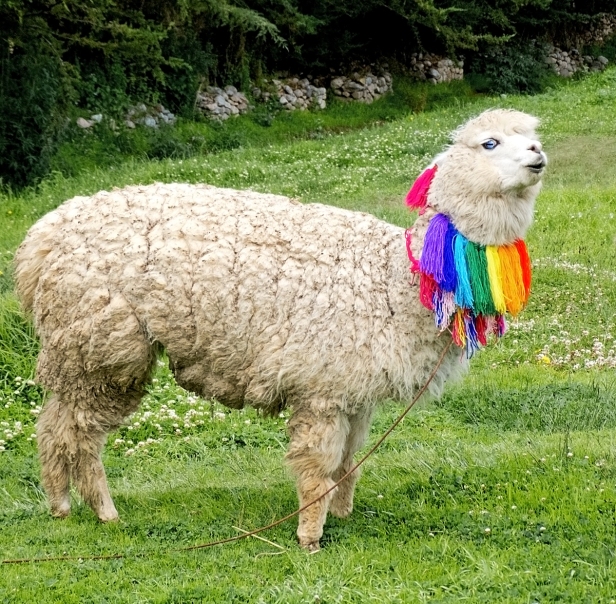
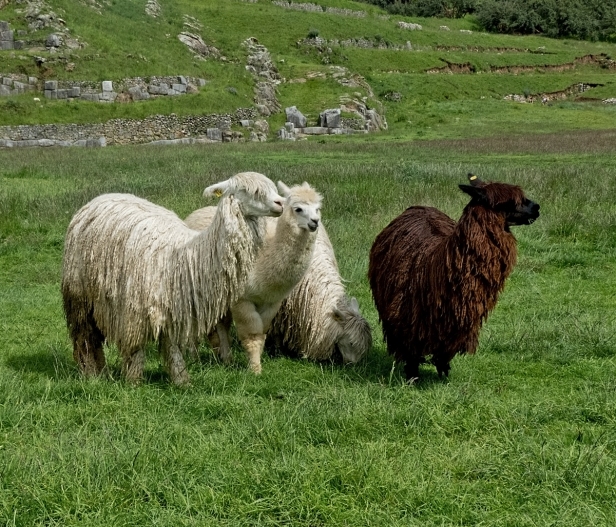
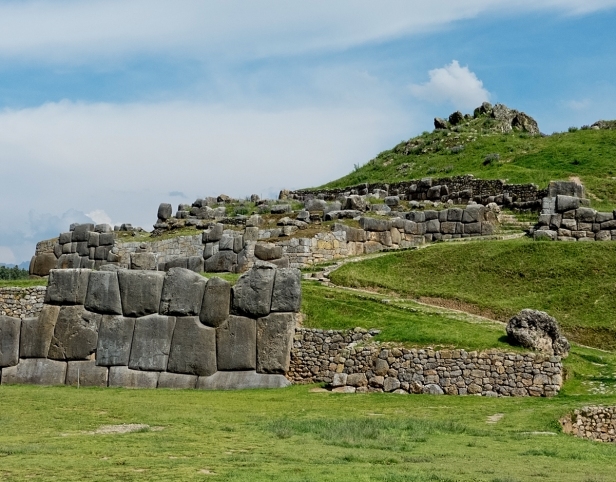

Near the town of Maras, about fifty kilometres from Cusco, is the Inca archeological site of Moray. It consists of enormous circular terraces, one within the other, down, and down, and down. It is 98 feet deep, and there is a temperature difference of about 15 degrees centigrade between the top and the bottom. There is a sophisticated irrigation system. Speculation is that it was created as a site for agricultural experiments, and to breed plants suitable for the harsh Andean climate, gradually acclimatizing them as they moved them up the terraces.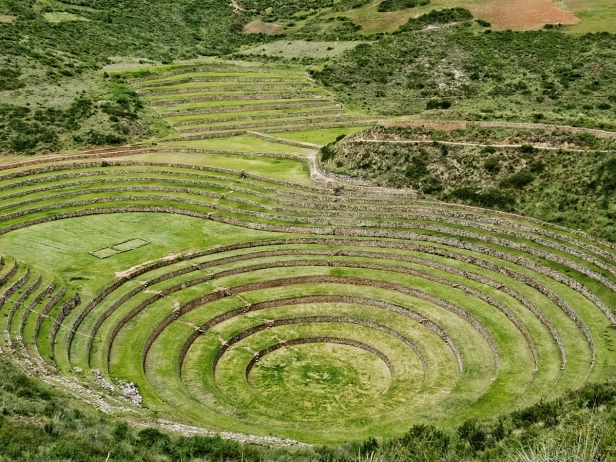
And close by are the salt evaporation ponds of Maras. This is a quite extraordinary place. Higher up above what can be seen in these photos there is a natural spring gushing out of the side of the mountain from an underground stream. It contains a very high volume of salt. When I asked our guide where the salt comes from he said from inside the mountain, and that they’d have to tear down the mountain to find out. Anyway, salt evaporation ponds, carefully sculpted and cascading down the side of the mountain, have been maintained communally here since pre-Incan times. There is also an intricate system for controlling the water, and for closing off the flow of water to each pond to allow it to evaporate leaving the salt crystals to be harvested. I am constantly astounded by human ingenuity.

Andean child 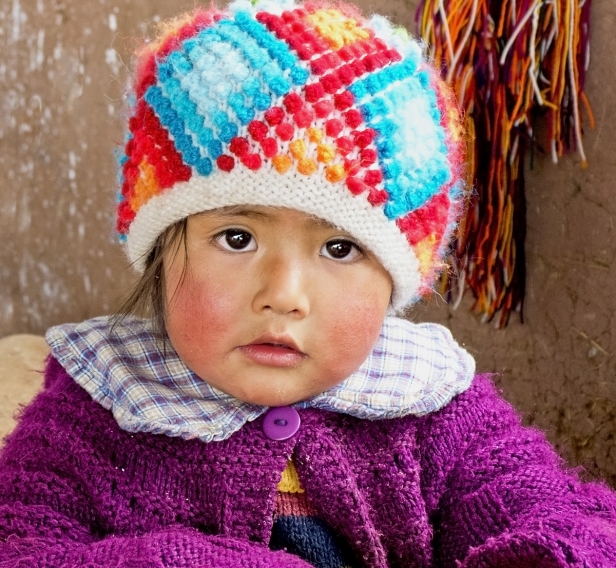
and rural life.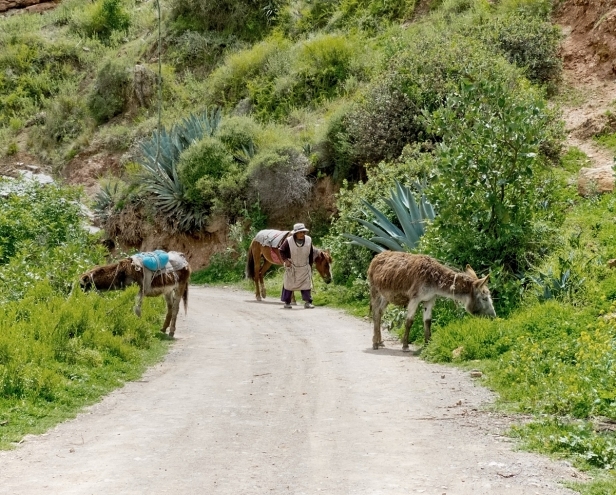
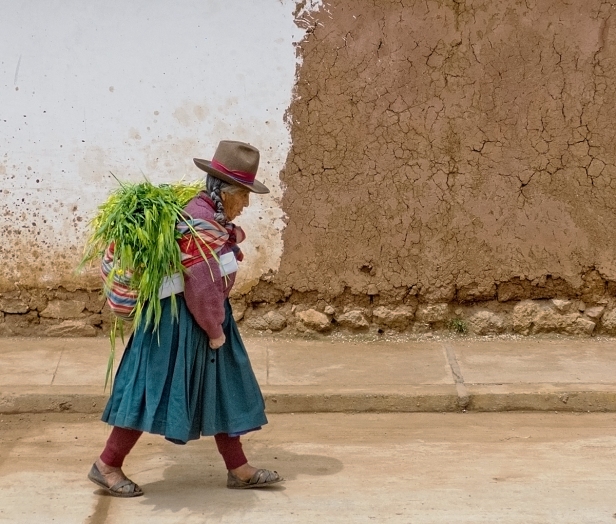
Next post: A trip to the village of Chinchero for their Sunday market, exploring some more Inca ruins located above the town, and, unexpectedly, a special local sacred ceremony. One very rich day.
All words and images by Alison Louise Armstrong unless otherwise noted.
© Alison Louise Armstrong and Adventures in Wonderland – a pilgrimage of the heart, 2010-2015.

All that open space is so wonderful. Yes, by the Grace of God, all of it. Such a lovely post.
LikeLike
Thank you Paulette. Yes, all that open space – by the Grace of God. I know exactly what you mean.
xoxox
LikeLike
Fabulous post, so well written. Ethereal photographs of a magical place. Bravo~
LikeLike
Thank you so much Cindy. I’m glad you enjoyed it. I rediscovered a freedom for doing this one. Makes it so much easier 🙂
LikeLike
I enjoyed reading your post. Thanks for those wonderful scenes , as I was there too!
LikeLike
Thanks Leonila. I’m glad you felt as if you were there with us.
Alison
LikeLike
yes of course, and I will be looking forward for your next post. By the way, I salute you guys, I love your life….have a happy days always.
LikeLike
Thanks Leonila, and happy days to you too!
LikeLike
Just amazing! Thanks so much for sharing your way…
LikeLike
Thanks, and you’re welcome. Alison xox
LikeLike
Your photos absolutely astonish me! I am really living vicariously through your blog. Any thoughts of publishing this (or part of this) as a book someday? It’s golden.
LikeLike
Thank you so much Silk. Yes, we do plan a book or two. The first will be a combination of photographs and quite short pieces of writing about the journey, some about the inner journey, some about the external journey. We’ll be back in Van June thru Nov and will probably get started on compiling it then. Thank you so much for the encouragement!
LikeLike
Would love to connect in person when you’re back in Vancouver.
LikeLike
Yes, me too. And with Helga.
LikeLike
I would so love that! You give me so much pleasure with your blog and I want to thank you in person. Let’s do it!
LikeLike
I love the image of the bicycling man who spotted you, who is obviously in that ageless state of fun, a grin forming inside of a question, a wordless human connection, a coat tail caught in the breeze, a bit of stealth and intrigue. There is movement, stillness, connection, joy, playfulness and timelessness all resonating within that image.
Michael
LikeLike
Oh you really see it! You see more than I ever saw in that moment. It was so brief. I saw him, held up the camera and clicked, and then we were gone. But he was right there, taking in what was happening and playing with it. I didn’t even know in the moment what I had captured. I wish I could show him! I can see him smiling and chuckling about it.
LikeLike
Yes. I wonder if you sent a copy to the postal service in the town if they might not find a way to get it to him? Ha! Really put your written spanglish to the test! All I know is there is a por favor, an ayudame, and a gracias in there somewhere.
Michael
LikeLike
Chuckle. I actually do understand that Spanish! However I have no way of knowing the name of the town, or even if there was a town, or just a lone farm building. Scurrying off to look at the photos taken immediately before and after to try to glean more information 🙂
LikeLike
Oh, that was taken from the back of the train? Wow. Doubly impressive. Well based on your post, I’d say it was about halfway between a lush field of crops and a plaza surrounded by impressive stone buildings… 🙂
Michael
LikeLike
Yes, that’s about it.
LikeLike
thank you so much for this informative post..very well written , many pictures resembles like the places ,shops and people in Nepal…much love and blessings to you both !!
LikeLike
Thank so much Alisha. We’ve not been to Nepal, but it’s on the list . . . . .
Love and blessings to you too, Alison
LikeLike
That doorway with the two mandalas–one of them looks to be Lord Jagannath, the ancient form of Krishna from Orissa in India! Thanks for your posts–I will be in Peru’s Sacred Valley in a few months. Love, Meg
LikeLike
Hi Meg! That is interesting. I just had another look at it, and the one on the left has that cross shape that is an ancient symbol here for the four main gods of the Quechua and Aymara (pre-Inca) people – each arm of the cross representing Sun, Earth (Pachamama), and I think the other two are fire and water, but I’m not sure. This cross is found integrated into many many designs here.
Have a wonderful time in Peru – it’s a really extraordinary place. Love, Ali
LikeLike
One more incredible post. Enjoyed reading it thoroughly 🙂
LikeLike
Thanks Sreejith.
LikeLike
I recently discovered your blog. It’s very well done! Your photos are very professional and your writing transports me. Thank you!
I wonder if you could explain a bit about the train? Can you give us a link or a name to google? I’d be very interested in taking that trip!
Libbie
LikeLike
Hi Libbie. Thank you so much for your wonderful compliments. I’m glad you’re enjoying the blog.
The train journey was with Peru Rail and really worth it.
http://www.perurail.com/tickets_buy.php
Happy travels! Alison
LikeLike
How’s your spanish coming? I think I have to wait for S.A. until I learn some. Thoughts?
LikeLike
Hi Rumplestiltskin 🙂
I knew a bit of Spanish before we went to Mexico, and Don learned some from a free online course while we were in Mexico. Even though we spent 5 months in Mexico, and now getting close to 6 months in SA our Spanish is minimal. Well it’s considerably better than when we started but it’s certainly no more than tourist Spanish. Just about everyone in the tourist industry speaks some English. Learn hello, thank you, and I’m sorry. I think you could manage. I think lots of tourists come here speaking no Spanish at all. If you learn the basics online you’ll be fine.
LikeLike
Beautiful! I read a book a while ago about an American journalist who set off to hike the Incan trail, and of course Cuzco came into it a lot. But it’s really cool to see your pictures and hear your stories of it. 🙂
LikeLike
Thanks Felicity, glad you enjoyed the post. I hiked the Inca Trail way back in ’78 when I first came to Peru – it was one of the great highlights of that trip. We didn’t do it this time for several reasons. What’s the name of the book – I’d be interested in having a look at it. Thanks, Alison
LikeLike
So many pictures – I love it!!!
LikeLike
Thanks Kelly ❤
LikeLike
Enjoyed your part Don, especially your observation on how your attitude towards money has changed. Alison, the picture of the man on the bicycle captured a priceless moment in time… a rare photo.
LikeLike
Thanks Shirley,
Neither Alison nor I know exactly why or when our attitudes towards money changed, but change they did. It came along with a shift in our beliefs to “LIfe’s too short to worry about anything”, and a determination not to let money fears get in the way of us seeing and doing as many of the wonderful things as there are to see and do wherever we happen to be in the world, South America being a prime example with Iguazu Falls, Patagonia, Bolivia, Machu Picchu, the Amazon jungle and the Galapagos Islands being just some of the amazing places we’ve been to on this journey. We know that may never get back to see them again in this lifetime, so we decided to go for as many of them as we could crowd into our schedule. What is most astonishing is that the more we’ve let go of money fears, the more the universe (aka God) has supported us to keep on doing what we’re doing.
LikeLike
I saw him on his bicycle, leaned out the back of the train and clicked. I had no idea what I was photographing. A gift. As you say, a priceless moment in time. I love his humour!
Alison
LikeLike
Love the photos. So vibrantly colorful and vivid.
LikeLike
Thanks Jun. I love the exuberant use of colour in South America. Mexico. India. Some people just know how to d colour! Makes my heart sing.
Alison
LikeLike
Love this! The playful picture of the man on the bicycle is wonderful.
LikeLike
Thanks Kay. As I said above, I had no idea what I was photographing. Loved it when I got it up on the computer – what a delightful surprise it was.
xox
LikeLike
Hello Alison,
We are still in the midst of the arduous task of divesting ourselves of our stuff. I have several questions and/or comments for you. Is it possible to private message you?
LikeLike
I’ll email you.
Alison
LikeLike
I have seen the stone work differences on documentaries, but I delight in the view from your lens. These different cultures, stacking on top of each other – the earliest the most sophisticated and in line with longevity of workmanship and shifting worlds – It really does seem like a real glimpse into a descent of understanding in MAN through the ages.
Also, had the same reaction as Michael to the man on the bicicleta; that moment is like so many in life, moments like that prompted me to start blogging, the playfulness of the moment available to us and everyone around if we are open to it.
Love and ease and play to you on your travels!
LikeLike
The stonework, and the layers of history draw you in. There’s definitely a similarity to the layers of history found in Europe that’s just not there in ‘Second World’ countries (US, Canada, Australia, etc). The place feels ancient because it is, and has an undeniable charisma.
Many people are commenting on the photo of the man on the bicycle. It was a fluke, a gift for us all from the Mystery. I’d love to be able to show it to him but have no idea how I’d even begin to find him short of doing a walking pilgrimage from Juliaca to Cusco and stopping every one I meet and asking ‘Do you know this man?’ Chuckle.
Love and ease and play to you too!
xox
LikeLike
Great title. Love the photos of the children. They both seem to be Fox’s age. I also love the color in these photos, Alison. Your eye is getting more transparent every post. Sorry, to hear about the quinoa juice. It sounded like the new Acai. Somethings are not in Whole Foods for a reason. 🙂 {{{hugs}}} Kozo
LikeLike
Thanks Kozo. Aren’t those children beautiful?! So very open. I do think they are about Fox’s age. I love the colour in all South America, but especially in the Andes – so exuberant and unrestrained. I think it was just me with the quinoa juice. Don was fine with it. I felt while drinking it that it didn’t feel quite right for this body, but drank it anyway because I liked the taste 🙂 A lesson to listen to the body eh?
LikeLike
A wonderful post!
LikeLike
Thanks Naomi. And thanks for catching up. I have a little catching up to do too 🙂
LikeLike
I do so enjoy reading your posts. The photos are fabulous. You make me feel like I am travelling right next to you.
LikeLike
Thank you so much Joanne. That’s the best compliment!
LikeLike
I never imagined there were luxury trains in South America. Is this just an anomaly, or are there other routes you can tour on in other countries ?
I am not excited about driving after the roads of Costa Rica, perhaps it is not fair to compare with Bolivia but touring a new country by train seems like fun.
LikeLike
I think it is an anomaly – this train and the train from Ollantaytambo to Cusco, both run by Peru Rail. We travelled by ‘luxury’ bus for over 2000km (Mendoza-Santiago-La Serena-Antofogasta-San Pedro de Atacama). See these posts
https://alisonanddon.wordpress.com/2013/12/31/buses-r-us-mendoza-to-antofagasta/https://alisonanddon.wordpress.com/2014/01/12/attitude-not-altitude-exploring-the-atacama-desert/
If you book only a week or 10 days before you can get the upstairs front window seats for an uninterrupted view – we thoroughly enjoyed travelling this way.
Also google ‘the man in seat 61’ for all kinds of info about train travel all over the world. Hope this helps. Cheers, Alison
LikeLike
Great pictures and stories behind your post. Love my travels in Peru. Lived in Chile for 3 years. Check out my blog http://adventuresofdejav.com/home/just-see/blog/ and provide suggestions.
LikeLike
Thanks so much. Peru was definitely one of our favourites too. Your blog looks very interesting with a lot of good information. Happy travels, and enjoy perth! Alison
LikeLike
So much fun reading these adventure stories. We took this same trip in the late 1970’s. Your photos are perfect reminders of what I saw back then. I well remember the train trip – wonderful even over thirty years ago.
LikeLike
Thanks Susan. It was fun for me to re-read this post. We’v done so much since then I’ve forgotten a lot of the details of our time in South America, only that it was all an amazing experience. It sure was different in the 70’s. I was also there sometime in the 70’s travelling as part of a north to south overland trip.
Alison
LikeLiked by 1 person
I can’t believe how great your pictures are. As a newbie photographer I hope that I get even a few pictures as good as yours!
LikeLiked by 1 person
Thank you so much. I have two sisters who have been professional photographers who taught me all I know. Lucky to have built-in teachers!
Alison
LikeLiked by 1 person